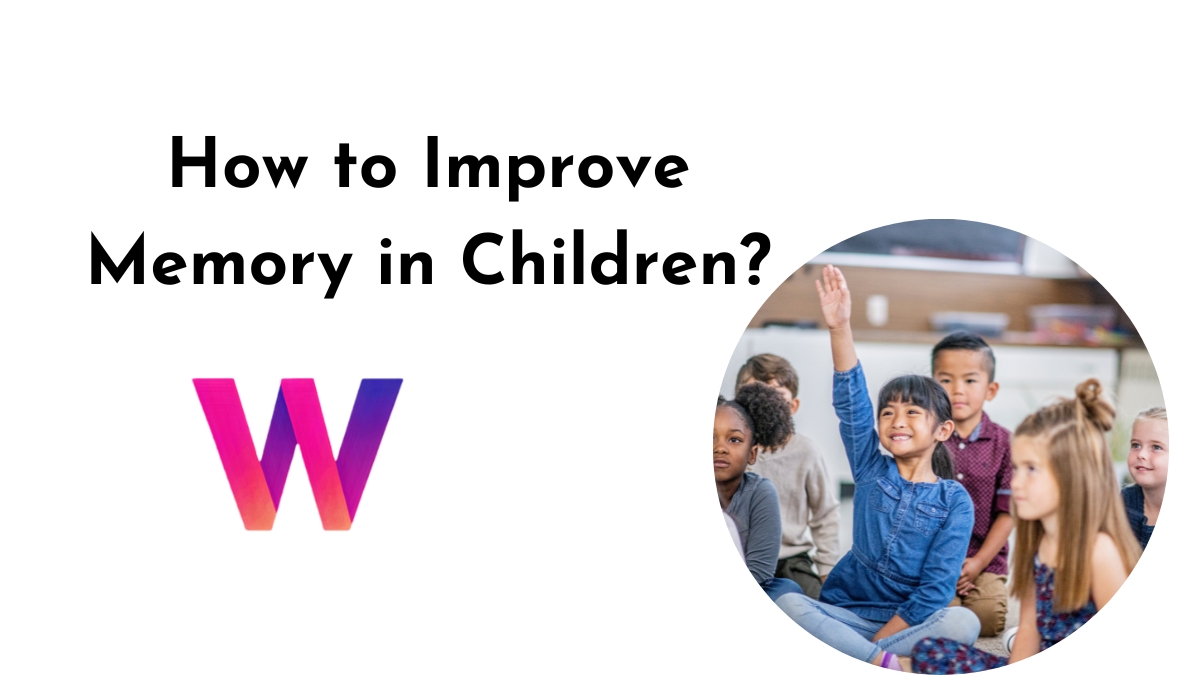Memory is a vital skill that helps children learn and succeed in school and life. Memory allows children to store and recall information, follow instructions, solve problems, and develop critical thinking. However, not all children have the same memory capacity or ability. Some children may struggle with remembering facts, names, dates, or procedures. This can affect their academic performance, confidence, and self-esteem.
Fortunately, memory is not a fixed trait that children are born with. Memory can be improved and enhanced with practice, strategies, and activities. In this article, we will explore some of the ways to Improve memory in children and help them achieve their full potential.
Table of Contents
What is Memory and Why is it Important?
Memory is the process of encoding, storing, and retrieving information in the brain. There are different types of memory that serve different purposes:
Sensory memory holds sensory impressions for a very brief time (less than a second). For example, when you see a flash of lightning or hear a clap of thunder, you retain that image or sound for a fraction of a second in your sensory memory.
Short-term memory (also called working memory) holds information for a short period of time (about 15 to 30 seconds) and allows us to manipulate and process it. For example, when you dial a phone number or do a mental calculation, you use your short-term memory. – Long-term memory holds information for a long period of time (from hours to years) and allows us to access it when needed. For example, when you recall your birthday or the name of your best friend, you use your long-term memory.
Memory is important for children because it enables them to:
– Learn new skills and concepts
– Follow directions and routines
– Complete tasks and assignments
– Participate in discussions and conversations
– Build knowledge and understanding – Develop creativity and imagination
How to Improve Memory in Children:
There are many ways to improve memory in children, depending on their age, interests, and learning styles. Here are some of the most effective methods that parents and teachers can use to help children boost their memory power:
1. Encourage questions and curiosity:
One of the best ways to improve memory in children is to encourage them to ask questions and be curious about the world around them. Questions help children focus their attention, clarify their understanding, and deepen their comprehension of the subject matter. Curiosity stimulates their brain activity, motivates them to learn more, and makes them more likely to remember what they have learned.
Parents and teachers can foster questions and curiosity by:
– Providing children with opportunities to explore different topics and subjects
– Asking open-ended questions that require more than yes or no answers
– Encouraging children to share their opinions and thoughts
– Praising children for their curiosity and enthusiasm – Providing feedback and guidance when needed
2. Use mnemonics and songs:
Mnemonics are memory aids that help children remember information by associating it with something else that is easier to recall. For example, acronyms (such as ROYGBIV for the colors of the rainbow), rhymes (such as “Thirty days hath September”), or images (such as picturing a cat on a mat to remember the word “cat”). Songs are another type of mnemonic that use music and rhythm to help children remember information. For example, singing the alphabet song or the multiplication tables.
Parents and teachers can use mnemonics and songs by:
– Teaching children how to create their own mnemonics based on their preferences
– Providing examples of mnemonics and songs that are relevant to the material
– Encouraging children to practice using mnemonics and songs regularly – Making mnemonics and songs fun and creative
3. Make learning exciting and active:
Children are more likely to remember information that is interesting, meaningful, and engaging. Therefore, parents and teachers should make learning exciting and active for children by using various methods and strategies. For example:
– Using games, puzzles, quizzes, experiments, or projects that challenge children’s memory skills
– Using stories, anecdotes, jokes, or examples that relate the information to children’s lives or interests
– Using multimedia tools such as videos, podcasts, animations, or interactive websites that appeal to children’s senses – Using hands-on activities such as crafts, models, or demonstrations that involve children’s physical movement
4. Use visual aids:
Visual aids are tools that help children remember information by presenting it in a visual form. For example, charts, graphs, diagrams, maps, pictures, or flashcards. Visual aids help children organize, summarize, and simplify the information. They also help children create mental images that can be recalled later.
Parents and teachers can use visual aids by:
– Providing children with visual aids that are clear, colorful, and relevant to the material
– Encouraging children to create their own visual aids based on their preferences
– Reviewing the visual aids with children and asking them questions about them – Displaying the visual aids in a visible place or keeping them handy for reference
5. Make connections and examples:
Making connections and examples helps children remember information by linking it to their prior knowledge, experiences, or emotions. For example, comparing and contrasting the information with something they already know, relating the information to a personal story or event, or applying the information to a real-world situation or problem. Making connections and examples helps children understand the information better and make it more relevant and memorable.
Parents and teachers can help children make connections and examples by:
– Asking children to explain how the information relates to something they already know or have learned before
– Sharing their own connections and examples that are appropriate and meaningful
– Encouraging children to use analogies, metaphors, or similes to describe the information – Helping children find practical or creative ways to use the information
6. Repeat and review:
Repetition and review are essential for improving memory in children. Repetition helps children consolidate the information in their long-term memory by strengthening the neural pathways in their brain. Review helps children retrieve the information from their long-term memory by activating the neural pathways in their brain. Repetition and review also help children identify and correct any errors or gaps in their memory.
Parents and teachers can help children repeat and review by:
– Repeating the information in different ways such as verbally, visually, or kinesthetically
– Reviewing the information at regular intervals such as daily, weekly, or monthly
– Using spaced repetition techniques such as increasing the time between reviews as the information becomes more familiar – Using retrieval practice techniques such as testing, quizzing, or self-explaining the information
7. Teach memory strategies:
Memory strategies are techniques that help children improve their memory skills by enhancing their attention, encoding, storage, or retrieval processes. For example, chunking (breaking down large amounts of information into smaller units), elaboration (adding more details or associations to the information), or imagery (creating vivid mental pictures of the information). Memory strategies can be taught explicitly or implicitly depending on the age and ability of the child.
Parents and teachers can teach memory strategies by:
– Explaining the purpose and benefits of using memory strategies
– Demonstrating how to use memory strategies step by step
– Providing opportunities for children to practice using memory strategies with guidance and feedback
– Encouraging children to choose and use memory strategies that suit their needs and preferences
[Also Read: The Benefits of Yoga]
Some common memory problems in children are:
Developmental and intellectual disabilities such as ADHD[1], autism, Down syndrome, or developmental language disorder. These conditions can affect working memory, which is the ability to hold and manipulate information for a short time. Children with working memory problems may have trouble following instructions, organizing their thoughts, or completing tasks.
Concussions and traumatic brain injuries (TBIs) caused by a sudden impact to the head or body. These injuries can affect short-term memory, which is the ability to remember recent events or information. Children with short-term memory problems may not remember what happened before or after the injury, or may have difficulty learning new things.
Medical and mental health disorders such as epilepsy, sleep deficiency, brain tumors, brain infections, substance abuse, PTSD, OCD, or bipolar disorder. These disorders can affect short-term or long-term memory, which is the ability to remember past events or information. Children with long-term memory problems may have trouble recalling facts, names, dates, or skills.
Childhood trauma such as abuse, neglect, violence, bullying, or loss. Trauma can affect short-term or long-term memory, especially if it is severe or chronic. Trauma can cause children to repress or forget painful memories, or to have flashbacks or nightmares that interfere with their memory.
Pediatric Autoimmune Neuropsychiatric Disorders Associated with Streptococcal Infections (PANDAS) and Pediatric Acute-onset Neuropsychiatric Syndrome (PANS). These are rare conditions that cause sudden and severe symptoms of OCD and other neuropsychiatric problems. They are also associated with a noticeable loss of non-verbal memory, which is the ability to remember visual or spatial information.
If you notice any signs of memory problems in your child, you should consult with your child’s doctor or teacher to rule out any serious issues and to get appropriate treatment and support.
If your child has ADHD and memory problems, you can help him or her by:
- Using visual aids, such as pictures, diagrams, or charts, to help them remember information. Visual aids can help your child organize, summarize, and simplify the information. They can also help your child create mental images that can be recalled later.
- Teaching memory strategies, such as acronyms, acrostics, or songs, to help them recall a series or sequence. Memory strategies can help your child remember information by associating it with something else that is easier to recall. For example, using ROYGBIV for the colors of the rainbow or “Please Excuse My Dear Aunt Sally” for the order of operations in math.
- Making learning exciting and active. Children with ADHD are more likely to remember information that is interesting, meaningful, and engaging. You can make learning fun and active for your child by using games, puzzles, quizzes, experiments, or projects that challenge their memory skills. You can also use stories, anecdotes, jokes, or examples that relate the information to their lives or interests.
- Using sensory cues. Sensory cues can help your child remember information by stimulating their brain activity and attention. For example, you can use the scent of peppermint to enhance alertness and learning. You can also use different colors, sounds, or textures to help your child remember information.
- Repeating and reviewing. Repetition and review are essential for improving memory in children with ADHD. Repetition helps your child consolidate the information in their long-term memory by strengthening the neural pathways in their brain. Review helps your child retrieve the information from their long-term memory by activating the neural pathways in their brain. You can help your child repeat and review by using different methods such as verbally, visually, or kinesthetically. You can also use spaced repetition and retrieval practice techniques to help your child remember information better.
- Using tools such as mnemonic devices, calendars, organization apps, and reminders to help them remember information, tasks, and events. Tools can help your child remember information by providing external support and cues. For example, you can use mnemonic devices to help your child remember names or facts. You can also use calendars to help your child remember appointments or deadlines. You can use organization apps to help your child keep track of their assignments or chores. You can use reminders to help your child remember what they need to do or bring.
- Trying mental exercises or brain training apps or games. Some research suggests that mental exercises or brain training apps or games may increase working memory in people with ADHD. Working memory is like a muscle that can be improved with exercise and training. You can find various working memory challenges online or on your smartphone or tablet.
FAQs:
Q: How can I test my child’s memory?
A: There are different ways to test your child’s memory depending on what type of memory you want to assess. For example:
– To test your child’s sensory memory, you can show your child a picture or play a sound for a brief moment and then ask your child to describe what he or she saw or heard.
– To test your child’s short-term memory, you can give your child a list of words or numbers to remember for a few seconds and then ask your child to repeat them back to you.
– To test your child’s long-term memory, you can ask your child questions about facts, events, or skills that he or she has learned before.
Q: How can I help my child with poor memory?
A: If your child has poor memory, you can help him or her by:
– Consulting with your child’s doctor or teacher to rule out any medical or learning issues that may affect your child’s memory
– Providing a supportive and stimulating environment for your child that is free of distractions and stress
– Using the methods and tips mentioned in this article to help your child improve his or her memory skills
– Praising your child for his or her efforts and achievements and encouraging your child to keep trying
Q: What are some fun memory games for kids?
A: Some fun memory games for kids are:
– Memory (or Concentration): A card game where players have to match pairs of cards with the same image by turning them over one at a time.
– Simon Says: A game where one player gives commands that start with “Simon says” and the other players have to follow them. If a command does not start with “Simon says”, the players should not follow it.
– I Spy: A game where one player chooses an object that is visible to everyone and says “I spy with my little eye something that is (color, shape, or feature)”. The other players have to guess what the object is. – I Went to the Market: A game where one player starts by saying “I went to the market and bought (an item)”. The next player repeats the sentence and adds another item. The game continues until someone forgets an item or makes a mistake.
Conclusion:
Memory is a vital skill that helps children learn and succeed in school and life. However, some children may have memory problems due to various factors such as developmental and intellectual disabilities, concussions and traumatic brain injuries, medical and mental health disorders, childhood trauma, or PANDAS and PANS. These memory problems can affect their short-term, long-term, or working memory, and cause difficulties in remembering information, following instructions, completing tasks, and more.
Fortunately, there are many ways to improve memory in children and help them overcome their challenges. Parents and teachers can use methods such as encouraging questions and curiosity, using mnemonics and songs, making learning exciting and active, using visual aids, making connections and examples, repeating and reviewing, teaching memory strategies, using tools such as mnemonic devices, calendars, organization apps, and reminders, and trying mental exercises or brain training apps or games. These methods can help children boost their memory power, enhance their learning abilities, and achieve their full potential.



